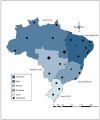Disparities in Healthcare Utilization Among Vulnerable Populations During the COVID-19 Pandemic in Brazil: An Intersectional Analysis
- PMID: 40566259
- PMCID: PMC12192583
- DOI: 10.3390/ijerph22060831
Disparities in Healthcare Utilization Among Vulnerable Populations During the COVID-19 Pandemic in Brazil: An Intersectional Analysis
Abstract
Background: Brazil's Unified Health System (Sistema Único de Saúde-SUS) has played a crucial role in reducing health disparities by providing universal and free healthcare to a diverse population. However, the COVID-19 pandemic exposed significant barriers to healthcare access among vulnerable groups, particularly due to the intersection of multiple vulnerabilities. This study aimed to examine how intersectionality-specifically sex/gender, race/ethnicity, and education level-has influenced inequalities in healthcare service utilization among vulnerable populations during the COVID-19 pandemic in Brazil.
Methods: This cross-sectional study is part of the "COVID-19 Social Thermometer in Brazil" project, conducted between May 2022 and October 2023 in Brazil's state capitals and the Federal District, focusing on populations considered socially vulnerable during the pandemic. Participants were selected using sequential sampling and completed a structured questionnaire. Statistical analyses-performed using Excel, RStudio (version 4.3.2), and ArcGIS-included sociodemographic profiling, the construction of the Jeopardy Index (a measure of social vulnerability), and binary logistic regression to explore associations between Jeopardy Index and healthcare service utilization.
Results: 3406 participants, the majority were men (60%), aged 30 to 59 years (65.1%), and identified as Black or Brown (72.2%). Most participants were concentrated in the Northeast (26.6%) and North (22.3%) macroregions. A high reliance on public healthcare services (SUS) was observed, particularly in the Southeast (96%). According to the Jeopardy Index, the most socially vulnerable groups-such as women, transgender individuals, Black people, and those with no formal education-were significantly more likely to rely on SUS (OR = 3.14; 95% CI: 1.34-7.35) and less likely to use private healthcare (OR = 0.07; 95% CI: 0.02-0.20), reflecting a 214% higher likelihood of SUS use and a 93% lower likelihood of private service utilization compared to the most privileged group.
Conclusions: Our findings reveal that individuals experiencing intersecting social vulnerabilities face marked inequalities in healthcare access. Without SUS, these populations would likely have been excluded from essential care. Strengthening SUS and implementing inclusive public policies are critical to reducing disparities and ensuring equitable healthcare access for historically marginalized groups.
Keywords: COVID-19; intersectional framework; public health services; social vulnerability.
Conflict of interest statement
The Authors declare that there is no conflicts of interest.
Figures





Similar articles
-
Disparities in Internet Medical Service Utilization Among Patients in Post-COVID-19 China: Cross-Sectional Study of Data From Provincial Field and National Online Surveys.J Med Internet Res. 2025 Aug 1;27:e60546. doi: 10.2196/60546. J Med Internet Res. 2025. PMID: 40749207 Free PMC article.
-
Inequities in the continuum of maternal care in Mexico: trends before and after COVID-19.Int J Equity Health. 2025 Jun 17;24(1):178. doi: 10.1186/s12939-025-02470-x. Int J Equity Health. 2025. PMID: 40528188 Free PMC article.
-
Antibody tests for identification of current and past infection with SARS-CoV-2.Cochrane Database Syst Rev. 2022 Nov 17;11(11):CD013652. doi: 10.1002/14651858.CD013652.pub2. Cochrane Database Syst Rev. 2022. PMID: 36394900 Free PMC article.
-
Measures implemented in the school setting to contain the COVID-19 pandemic.Cochrane Database Syst Rev. 2022 Jan 17;1(1):CD015029. doi: 10.1002/14651858.CD015029. Cochrane Database Syst Rev. 2022. Update in: Cochrane Database Syst Rev. 2024 May 2;5:CD015029. doi: 10.1002/14651858.CD015029.pub2. PMID: 35037252 Free PMC article. Updated.
-
Signs and symptoms to determine if a patient presenting in primary care or hospital outpatient settings has COVID-19.Cochrane Database Syst Rev. 2022 May 20;5(5):CD013665. doi: 10.1002/14651858.CD013665.pub3. Cochrane Database Syst Rev. 2022. PMID: 35593186 Free PMC article.
References
-
- FGV SOCIAL Mapa da Nova Pobreza: Retrato da Pobreza No Brasil em 2021. [(accessed on 30 April 2025)]. Available online: https://repositorio.fgv.br/server/api/core/bitstreams/80762296-e1b2-46da....
-
- Instituto Brasileiro de Geografia e Estatística (IBGE) Síntese de Indicadores Sociais: Uma Análise das Condições de vida da População Brasileira. [(accessed on 30 April 2025)];2019 Available online: https://biblioteca.ibge.gov.br/visualizacao/livros/liv101681_informativo....
MeSH terms
Grants and funding
LinkOut - more resources
Full Text Sources
Medical

